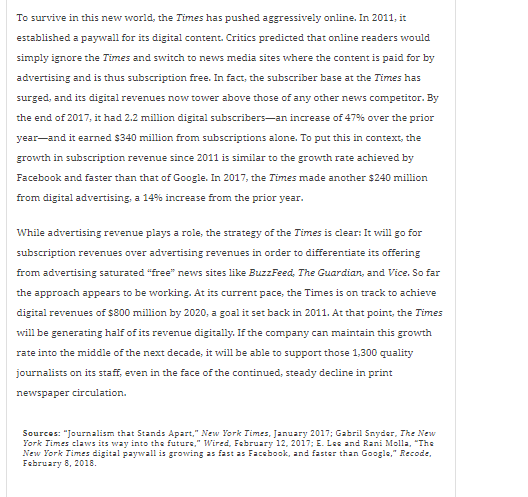Question
Please ASAPP I HAVE ONLY 50 MINUTES PLEASE HELP ME. answer in your own terms ASAPPP PLEASE SUBJECT: Strategic Management Case Study SWOT Analysis of:
Please ASAPP I HAVE ONLY 50 MINUTES PLEASE HELP ME. answer in your own terms ASAPPP PLEASE
SUBJECT: Strategic Management
Case Study SWOT Analysis of: Reinventing The New York Times


The following are the general guidelines for this assignment:
Minimum 650 words for this case
Recommendations are also to be provided with the SWOT as a 5th section.
No SWOT will contain more than 3 items for any part of the assignment (S,W,O,T or Recommendations). This is to reinforce the importance of the SWOT model as a tool used for depth in analysisnot breadth.
All analysis is to be from the perspective of the companynot the individual employee.
Opening Case Reinventing The New York Times The 167-year-old New York Times has long been regarded as one of the premium newspapers in the United States, with a reputation for producing original, authoritative, in-depth, quality journalism. The articulated strategy of the Times is to provide journalism "so strong that several million people around the world are willing to pay for it," Maintaining that reputation does not come cheap. The Times employs some 1,300 fulltime journalists, more than any other U.S. newspaper. In 2016, the company's journalists filed stories from more than 150 countries-nearly 80% of all countries on the planet. This gives the Times an international reach that far outstrips its rivals. Its reputation makes it the employer of choice for many top journalists, and the paper has a reputation for hiring some of the field's most creative people. But that top-tier journalistic brain trust is an expensive asset to maintain. Details pumkinpie/Alamy Stock Photo The evidence suggests that the Times has been successful in its quest for quality. It is by far the most cited news publisher by other media organizations, the most discussed on Twitter, and the most searched on Google. That being said, like all traditional print media outlets, the Times is facing an existential threat as the world transitions from print to digital media for its news. Print newspapers were once a highly successful business, generating steady revenue growth from a combination of subscriptions and advertising, but the Internet has changed all of that. Today, revenue from print subscriptions and print ads are in decline. At the Times, the print business has been shrinking by 4% a year since 2011. To survive in this new world, the Times has pushed aggressively online. In 2011, it established a paywall for its digital content. Critics predicted that online readers would simply ignore the Times and switch to news media sites where the content is paid for by advertising and is thus subscription free. In fact, the subscriber base at the Times has surged, and its digital revenues now tower above those of any other news competitor. By the end of 2017, it had 2.2 million digital subscribers-an increase of 47% over the prior year-and it earned $340 million from subscriptions alone. To put this in context, the growth in subscription revenue since 2011 is similar to the growth rate achieved by Facebook and faster than that of Google. In 2017, the Times made another $240 million from digital advertising, a 14% increase from the prior year. While advertising revenue plays a role, the strategy of the Times is clear: It will go for subscription revenues over advertising revenues in order to differentiate its offering from advertising saturated "free" news sites like BuzzFeed, The Guardian, and Vice, So far the approach appears to be working. At its current pace, the Times is on track to achieve digital revenues of $800 million by 2020 , a goal it set back in 2011. At that point, the Times will be generating half of its revenue digitally. If the company can maintain this growth rate into the middle of the next decade, it will be able to support those 1,300 quality journalists on its staff, even in the face of the continued, steady decline in print newspaper circulation. Sources: "Journalism that Stands Apart," New York Iimes, January 2017; Gabril Snyder, The New York Times claws its way into the future," Wired, Eabruary 12, 2017; E. Lae and Rani Molla, "The New York Times digital paywall is growing as fast as Facebook, and faster than Google," Recode, February 8, 2018
Step by Step Solution
There are 3 Steps involved in it
Step: 1

Get Instant Access to Expert-Tailored Solutions
See step-by-step solutions with expert insights and AI powered tools for academic success
Step: 2

Step: 3

Ace Your Homework with AI
Get the answers you need in no time with our AI-driven, step-by-step assistance
Get Started


